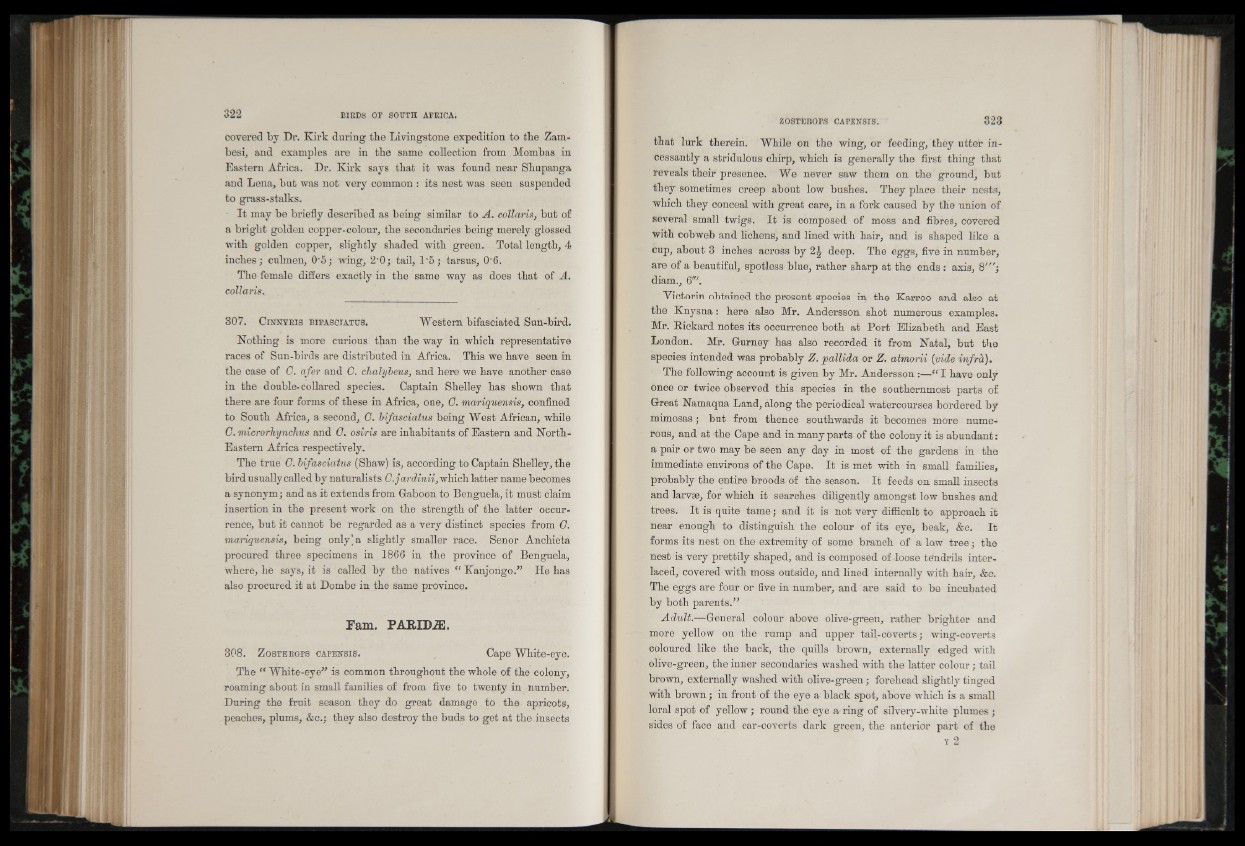
covered by Dr. Kirk during the Livingstone expedition to the Zambesi,
and examples are in tbe same collection from Mombas in
Eastern Africa. Dr. Kirk says that it was found near Shupanga
and Lena, but was not very common : its nest was seen suspended
to grass-stalks.
It may be briefly described as being similar to A. collaris, but of
a bright golden copper-colour, the secondaries being merely glossed
with golden copper, slightly shaded with green. Total length, 4
inches; culmen, 0*5; wing, 2'0 ; tail, l ’o; tarsus, 0-6.
The female differs exactly in the same way as does that of A.
collaris.
3 0 7 . C in n y r is b ifasc ia tu s . Western bifasciated Sun-bird.
Nothing is more curious than the way in which representative
races of Sun-birds are distributed in Africa. This we have seen in
the case of G. afer and G. chalybeus, and here we have another case
in the double-collared species. Captain Shelley has shown that
there are four forms of these in Africa, one, 0. mariquensis, confined
to South Africa, a second, G. bifasciatus being West African, while
C. microrhynchus and G. osiris are inhabitants of Eastern and North-
Eastern Africa respectively.
The true G. bifasciatus (Shaw) is, according to Captain Shelley, the
bird usually called by naturalists G.jardinii, which latter name becomes
a synonym; and as it extends from Gaboon to Benguela, it must claim
insertion in the present work on the strength of the latter occurrence,
but it cannot be regarded as a very distinct species from G.
mariquensis, being only’a slightly smaller face. Senor Anchieta
procured three specimens in 1866 in the province of Benguela,
where, he says, it is called by the natives “ Kanjorigo.” He has
also procured it at Dombe in the same province.
Fam. PARIDiE.
3 0 8 . Z o st er o p s c a pe n s is . Cape White-eye.
The fr White-eye” is common throughout the whole of the colony,
roaming about in small families of from five to twenty in number.
During the fruit season they do great damage to the apricots,
peaches, plums, &c.; they also destroy the buds to get at the insects
that lurk therein. While on the wing, or feeding, they utter incessantly
a stridulous chirp, which is generally the first thing that
reveals their presence. We never saw them on the ground, but
they sometimes creep about low bushes. They place their nests,
which they conceal with great care, in a fork caused by the union of
several small twigs. It is composed of moss and fibres, covered
with cobweb and lichens, and lined with hair, and is shaped like a
cup, about 3 inches across by 2J deep. The eggs, five in number,
are of a beautiful, spotless blue, rather sharp at the ends : axis, 8'";
diam.,
Yictorin obtained the present species in the Karroo and also at
the Knysna : here also Mr. Andersson shot numerous examples.
Mr. Rickard notes its occurrence both at Port Elizabeth and East
London. Mr. Gurney has also recorded it from Natal, but the
species intended was probably Z. pallida or Z. atmorii {vidé infra).
The following account is given by Mr. Andersson :—“ I have only
once or twice observed this species in the southernmost parts of
Great Namaqua Land, along the periodical watercourses bordered by
mimosas ; but from thence southwards it becomes more numerous,
and at -the Gape and in many parts of the colony it is abundant :
a pair or two may be seen any day in most of the gardens in the
immediate environs of the Cape. It is met with in small families,
probably the entire broods of the season. It feeds on small insects
and larvae, for which it searches diligently amongst low bushes and
trees. It is quite tame ; and it is not very difficult to approach it
near enough to distinguish the colour of its eye, beak, &c. It
forms its nest on the extremity of some branch of a low tree ; the
nest is very prettily shaped, and is composed of loose tëndrils interlaced,
covered with moss outside, and lined internally with hair, &c.
The eggs are four or five in number, and are said to be incubated
by both parents.”
Adult.—General colour above olive-green, rather brighter and
more yellow on the rump and upper tail-coverts ; wing-coverts
coloured like the back, the quills brown, externally edged with
olive-green, the inner secondaries washed with the latter colour ; tail
brown, externally washed with olive-green ; forehead slightly tinged
with brown ; in front of the eye a black spot, above which is a small
loral spot of yellow ; round the eye a ring of silvery-white plumes ;
sides of face and ear-coverts dark green, the anterior part of the